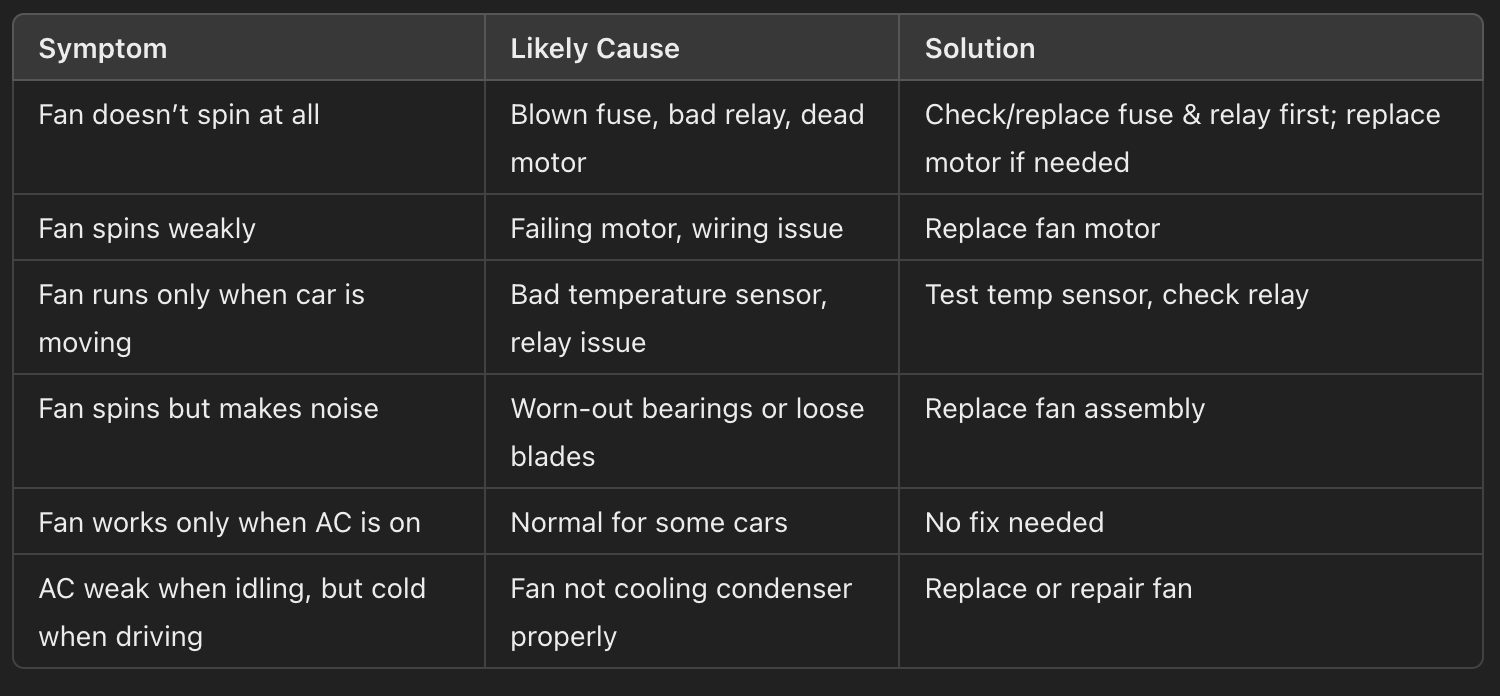AC Condenser Radiator Mounted Fan
AC Condenser Radiator Fan By Vehicle
Find your car manufacturer and or model vehicle you need to find an ac condenser radiator mounted fan below. We have majority of the automobile listed here to help you locate or narrow down your search. If for any reason you are unable to identify the vehicle you own, please you our instant messenger located to the bottom right of this window. One of our auto part specialist will help you locate the ac condenser assembly you need.
🔧 What is a Radiator-Mounted AC Condenser Fan?
Unlike standalone AC condenser fans (which only cool the AC system), radiator-mounted fans pull double duty:
✔️
Cools the engine radiator—Helps prevent overheating.
✔️
Cools the AC condenser—Ensures refrigerant stays cold for proper AC performance.
This fan is usually electric (on modern vehicles) or belt-driven (on older models). It's mounted directly behind the radiator, and when it stops working, both the AC and engine cooling system suffer.
FAQs AC Condenser Fans ❄️🚗
What’s the difference between a radiator-mounted fan and a standalone AC condenser fan?
A radiator-mounted fan cools both the engine radiator and AC condenser, while a standalone AC condenser fan is dedicated only to the AC system. Many modern cars combine both functions into one electric fan assembly, but some vehicles have separate fans.
How do I know if my radiator-mounted fan is failing?
Look for these symptoms:
✅ AC blows warm at idle but gets cold while driving.
✅ Engine temperature climbs in stop-and-go traffic.
✅ Loud fan noises (grinding, rattling, or clicking).
✅ Fan doesn’t spin when AC is turned on.
✅ Overheating warning light comes on.
What Happens If You Ignore a Bad Radiator-Mounted Fan?
🔴 AC System Damage – Without airflow, the condenser stays too hot, causing AC performance to drop and eventually leading to compressor failure.
🔴 Engine Overheating – If the fan isn’t cooling the radiator, the engine temperature skyrockets, increasing the risk of head gasket failure or engine damage.
🔴 Increased Fuel Consumption – A failing fan makes your AC work harder, leading to higher fuel usage.
🔴 Expensive Repairs – A $100-$300 fan replacement is way cheaper than a $1,500+ engine or AC system overhaul.
How to Check if Your Radiator-Mounted Fan is Working
✔️ Turn on your car’s AC at max cooling while parked.
✔️ Open the hood and look at the fan behind the radiator.
✔️ Check for these issues:
❌ Not spinning at all? It’s dead or has an electrical issue.
❌ Spinning weakly or inconsistently? The motor is failing.
❌ Loud clicking or grinding noise? It’s on its last legs.
❌ Works only when the car is moving? The fan relay, fuse, or motor may be bad.
Can I drive with a broken radiator-mounted AC condenser fan?
🚨 Not recommended! 🚨
A non-working fan can cause your AC system to overheat and eventually lead to compressor failure or engine overheating. If you must drive, avoid heavy traffic and high temperatures, but fix it ASAP to prevent costly repairs.
Why does my AC work while driving but not when idling?
When you're moving, airflow naturally cools the AC condenser and radiator. But at idle, the radiator-mounted fan must provide cooling—if it's not working, the AC struggles, leading to warm air.
How much does it cost to replace a radiator-mounted AC condenser fan?
💰 Parts Cost: $100-$400 (depending on vehicle)
💰 Labor Cost: $200-$500 (if done by a mechanic)
💰 DIY Savings: $200+ if you replace it yourself!
What causes a radiator-mounted fan to stop working?
🔴 Blown fuse or bad relay – The most common, cheapest fix.
🔴 Faulty fan motor – If the fan doesn’t spin, the motor may be dead.
🔴 Wiring issues – Loose or damaged wiring can prevent operation.
🔴 Temperature sensor failure – The fan won’t turn on when needed.
🔴 Obstruction – Dirt, debris, or broken blades can jam the fan.
Should I replace the fan motor or the entire fan assembly?
If only the motor is bad, some cars allow just replacing the motor. However, most modern vehicles use sealed fan assemblies, meaning you must replace the entire fan unit.
How long does a radiator-mounted fan last?
Most last 8-10 years, but lifespan depends on usage, climate, and maintenance. If you're frequently in hot climates or stop-and-go traffic, your fan works harder and wears out faster.
Can I install an aftermarket radiator-mounted fan for better cooling?
Yes, but be careful! Aftermarket fans can provide stronger airflow, but:
⚠️ They must match your vehicle’s voltage and mounting points.
⚠️ Poor-quality fans may wear out faster or cause electrical issues.
⚠️ Universal fans might require modifications.
For the best performance, OEM or high-quality aftermarket fans are the safest bet.
Why is my radiator-mounted fan running all the time?
❄️ Possible reasons:
Stuck relay or faulty temperature sensor (tells the fan to stay on).
AC is always on (many fans stay on when AC is running).
Overheating issue (the fan works overtime to compensate).
If the fan never shuts off, get it checked before it drains your battery or burns out.
How do I test my radiator-mounted AC condenser fan?
✔️ Turn on the AC to max cooling while the car is idling.
✔️ Check if the fan behind the radiator is spinning.
✔️ If it’s not working:
🔹 Check the fuse and relay first.
🔹 Try spinning it manually (with the car OFF!)—if it’s stiff, the motor is likely bad.
🔹 Use a multimeter to check power at the fan motor.
Can I replace my radiator-mounted fan myself?
🛠️ Yes! If you're comfortable with basic tools and car maintenance, it’s a moderate difficulty job. Most installs take 1-2 hours, but some cars require removing the bumper or radiator, making it harder.
Will a bad fan make my car overheat even if the AC is off?
✅ Yes! The radiator-mounted fan cools both the AC condenser and engine radiator, so even if you never use AC, a bad fan can cause overheating issues.
What happens if my radiator fan only works sometimes?
⚠️ Intermittent fan operation means failure is coming soon.
Possible causes:
🔹 Failing relay or temperature sensor
🔹 Loose wiring or bad ground connection
🔹 Weak fan motor that’s on its last legs
If the fan is inconsistent, fix it now before you’re stranded with a blown AC and an overheating engine.
Should both radiator-mounted fans run at the same time?
Depends on your car:
✔️ Single-fan setups—Runs at different speeds depending on temperature/AC load.
✔️ Dual-fan setups—One fan might be for AC only, while the other is for engine cooling.
If one isn’t running when it should, it may be failing or controlled by a separate relay.
🚗 How to Quickly Diagnose a Faulty AC Condenser Radiator-Mounted Fan ❄️
If your AC is weak at idle, your engine is running hot, or you hear strange fan noises, you need to diagnose your radiator-mounted fan ASAP before bigger (and more expensive) problems occur.
Here’s a quick, step-by-step guide to figuring out if your fan is the problem!
🛠️ Step 1: The 60-Second Quick Check
✔️
Turn your car on.
✔️
Turn the AC to MAX cold.
✔️
Pop the hood and check if the fan is spinning.
👉
If the fan is NOT spinning =
Possible issue (go to Step 2).
👉
If the fan is spinning weakly, slowly, or erratically =
It’s failing.
👉
If the fan runs loud or makes grinding noises =
Motor or blade issue.
🛠️ Step 2: The Manual Spin Test
🔧 With the engine OFF, spin the fan blades by hand.
✅
If it spins freely? The fan motor might still be working, but check electrical issues.
❌
If it’s stiff, stuck, or grinding? The fan motor is likely burnt out and needs replacement.
🛠️ Step 3: The Fuse & Relay Test (Cheap Fix First!)
⚡ Most radiator-mounted AC condenser fans fail due to a blown fuse or bad relay—so check these before replacing anything!
📌
Find your fuse box (under the hood, near the battery).
📌
Look for the fan fuse & relay (refer to your owner’s manual).
📌
Swap the fan relay with another identical one (like the horn relay).
👉
If the fan starts working, you had a bad relay! (Replace it—$10 fix!)
👉
If the fuse is blown, replace it and see if the fan works.
❌ If the new fuse blows immediately? You may have a shorted fan motor or wiring issue.
🛠️ Step 4: The Direct Power Test (Verifies If the Fan Motor is Dead)
This test bypasses wiring to see if the fan motor is actually working.
🔹 What you need: Two jumper wires or alligator clips.
🔹 Steps:
1️⃣ Disconnect the fan connector.
2️⃣ Connect the fan motor directly to the
battery’s positive and negative terminals.
3️⃣ Watch what happens:
✅
Fan spins at full speed? The motor is fine, and your issue is with the
relay, fuse, or wiring.
❌
Fan doesn’t spin? The motor is dead—replace the fan assembly.
❌
Fan spins weakly? The motor is failing—replace it before it stops completely.
🛠️ Step 5: Scan for Engine Codes (If Available)
Some vehicles will trigger a check engine light or AC system error if the fan isn’t working properly.
✅ Plug in an OBD-II scanner to check for cooling fan or temperature sensor-related error codes (like P0480-P0483).
🚀 Final Diagnosis Guide: What Your Results Mean
🔧 DIY Fix: How to Replace a Radiator-Mounted AC Condenser Fan
So, your AC condenser fan is dead, and your car’s air conditioning is struggling—or worse, blowing hot air. Instead of sweating through summer and paying a shop $500+ in labor, let’s replace it yourself.
Introduction
💰 DIY Cost:
$100-$300 (fan) vs. $500-$800 (shop repair)
⏳ Time Required: 1-2 hours
🛠️ Skill Level:
Moderate
🔩 Tools Needed
✔️ New radiator-mounted fan (match for your car)
✔️ Ratchet & socket set
✔️ Screwdrivers
✔️ Trim removal tool
✔️ Pliers
✔️ Work gloves
Step-by-Step Replacement Guide
✅
1. Disconnect the Battery – Safety first!
✅
2. Remove Any Plastic Covers or the Front Bumper (if needed for access).
✅
3. Unplug the Fan’s Electrical Connector and remove mounting bolts.
✅
4. Carefully Remove the Old Fan Assembly.
✅
5. Install the New Fan & Secure the Bolts.
✅
6. Plug in the Electrical Connector.
✅
7. Reassemble Covers & Bumper, then Reconnect the Battery.
✅
8. Start the Car & Test the Fan with AC at Max.



